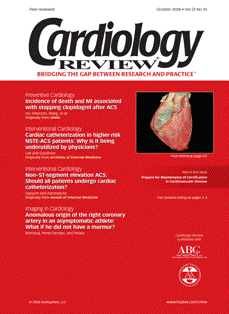Gas pain: A diagnosis in the waves
A 59-year-old Indian man with a medical history significant for orally controlled diabetes presented to the emergency department after experiencing a witnessed seizure.
A 59-year-old Indian man with a medical history significant for orally controlled diabetes presented to the emergency department after experiencing a witnessed seizure. His only symptom on presentation was some shortness of breath while walking. He noted that this symptom started 3 weeks earlier after he experienced a stomach virus that resulted in a few days of “gas pain.” His vital signs included a temperature of 36.4°C, heart rate of 109 beats per minute, blood pressure of 113/72 mm Hg, oxygen saturation of 92% on room air, and respiratory rate of 18 breaths per minute. His blood glucose level was 311 mg/dL. Auscultation of his chest revealed wet rales in the lower one-third of his lungs bilaterally. An electrocardiogram (ECG) was performed.
Diagnosis: Subacute myocardial infarction.
The patient’s electrocardiogram (ECG) shows large Q waves in leads V1 to V6 and complete absence of R wave progression through the precordium. Slight ST-segment elevation is seen in leads V2 to V5. T-wave inversion is apparent laterally and throughout the precordium. A left anterior hemiblock and left atrial enlargement are also present, as evidenced by the biphasic P wave in lead V1. The ECG indicates the patient experienced a subacute large anterior wall myocardial infarction (MI).
The patient’s chest radiograph demonstrated mild vascular congestion. His creatinine kinase level was normal, but his troponin T and pro-brain natriuretic peptide were elevated at 0.15 ng/mL (normal, <0.03 ng/mL) and 3057 pmol/L (normal, <400 pmol/L), respectively. Echocardiography revealed anterior wall akinesis with an ejection fraction of 10%. Cardiac catheterization revealed a 99% proximal left anterior descending artery (LAD) stenosis, which was stented, 100% mid-LAD occlusion, and 50% right coronary artery occlusion. He was started on aspirin, carvedilol (Coreg), an angiotensin-converting enzyme inhibitor, and a cholesterol-lowering statin, and he received an implantable cardioverter-defibrillator during his inpatient stay.
The patient’s seizure likely followed an episode of ventricular tachycardia-induced syncope. The witnessed seizure activity probably occurred secondary to cerebral hypoxia from the nonperfusing dysrhythmia and likely resolved with the spontaneous resumption of a perfusing sinus rhythm.
The sequence of ECG changes typically observed in the setting of acute ST-segment elevation MI begins with transient, marked, peaked T waves (“hyperacute” T waves) in the involved area of infarction. These may be missed as the hyperacute T waves resolve and are replaced with ST-segment elevation, which is usually convex and can last from hours to weeks. Pathologic Q waves typically develop while the ST-segment elevation is still evident, and are commonly seen 8 to 12 hours into the MI. As the ST-segment elevation resolves, T wave inversions may be seen in the involved leads, which may persist indefinitely. Pathologic Q waves persist in 60% to 80% of cases.1
An atypical presentation of acute MI is common, with about one-third of patients lacking chest pain upon presentation.2 Multiple studies have identified risk factors for atypical acute MI presentations.2-4 In descending order of prevalence, these include previous heart failure, previous stroke, older age, diabetes, female sex, and nonwhite ethnicity.2 The most common atypical symptoms in the elderly are dyspnea, syncope, confusion, stroke, fatigue, and nausea or emesis, whereas in diabetics the most frequent atypical symptoms are dyspnea, nausea or vomiting, confusion, and fatigue.3,4
Although atypical presentations are more prevalent in the elderly, diabetics, and those with multiple comorbidities, any patient can present with atypical symptoms. Our patient’s case serves as a good reminder to emergency physicians and primary care givers about atypical presentations of acute MI and the devastation that can result when the symptoms go unrecognized by the patient. The patient in this case believed that his epigastric pain 3 weeks earlier was from “gas” when in fact it stemmed from a massive MI. Had the patient presented to the emergency department at that time, his subsequent heart failure would likely have been avoided by early intervention, keeping his myocardial tissue viable.
Case report
